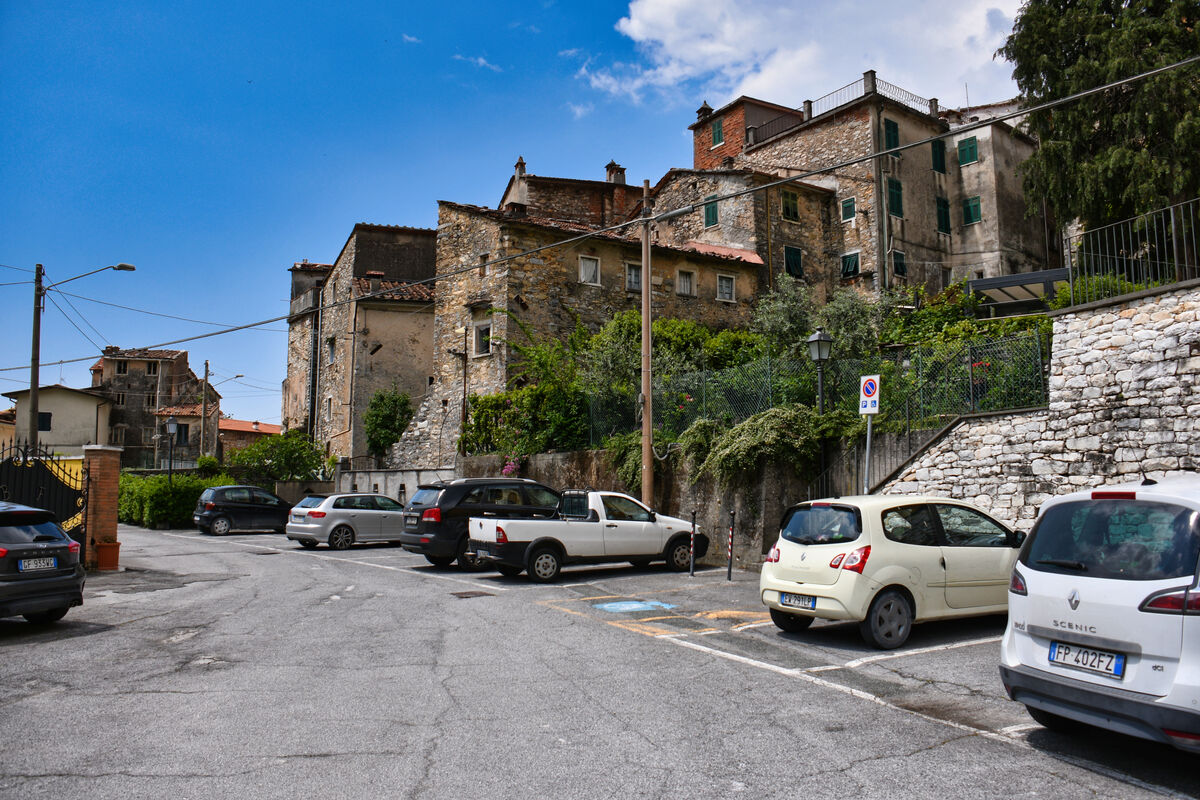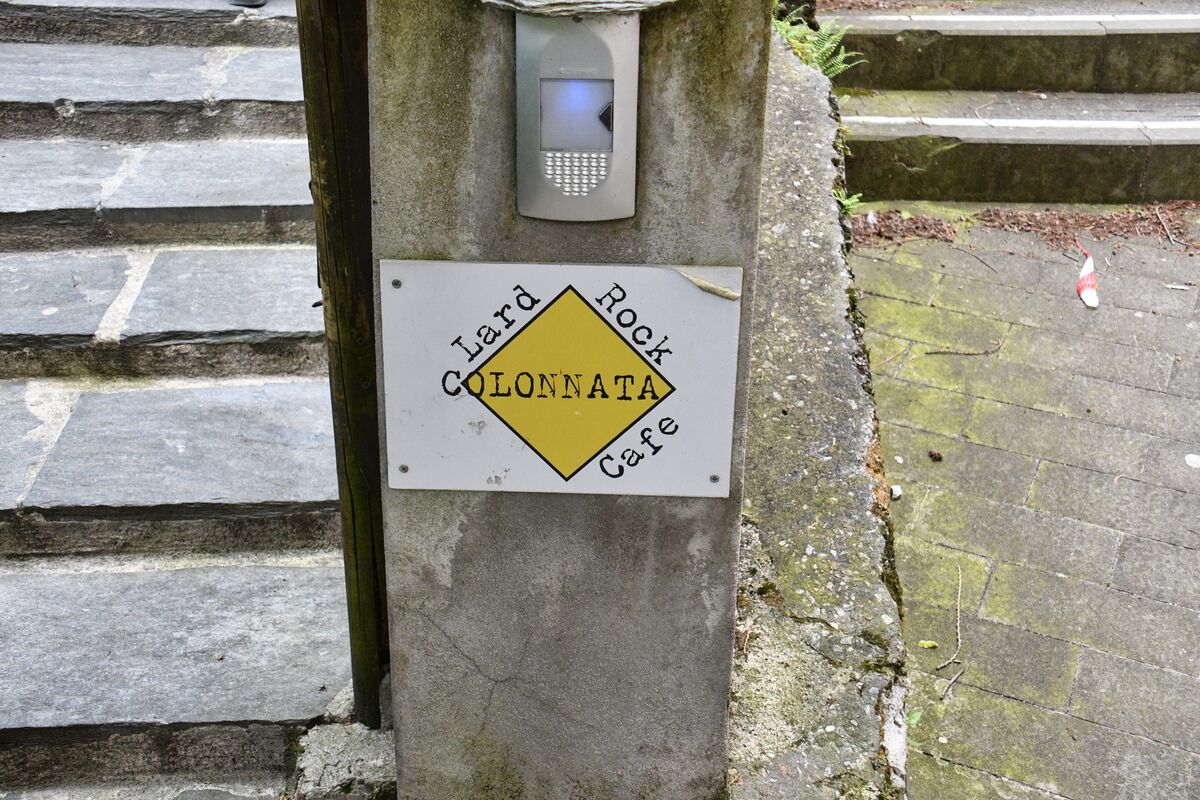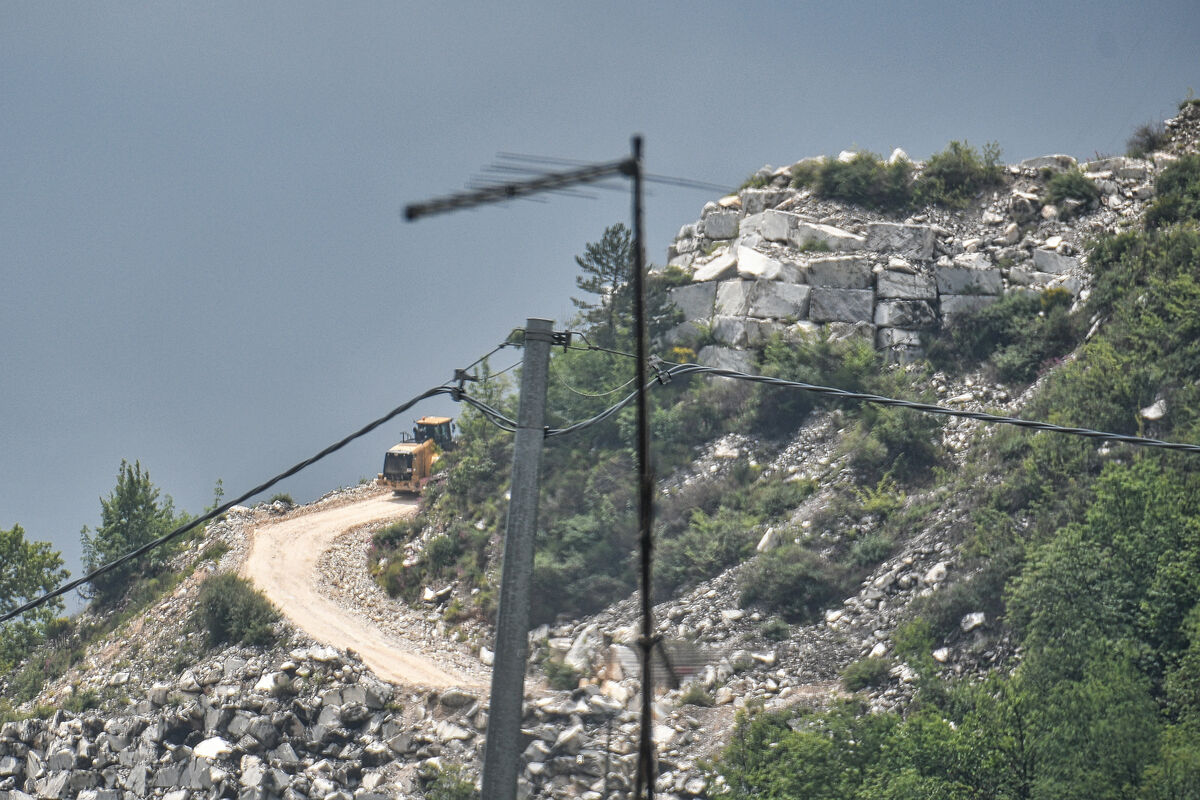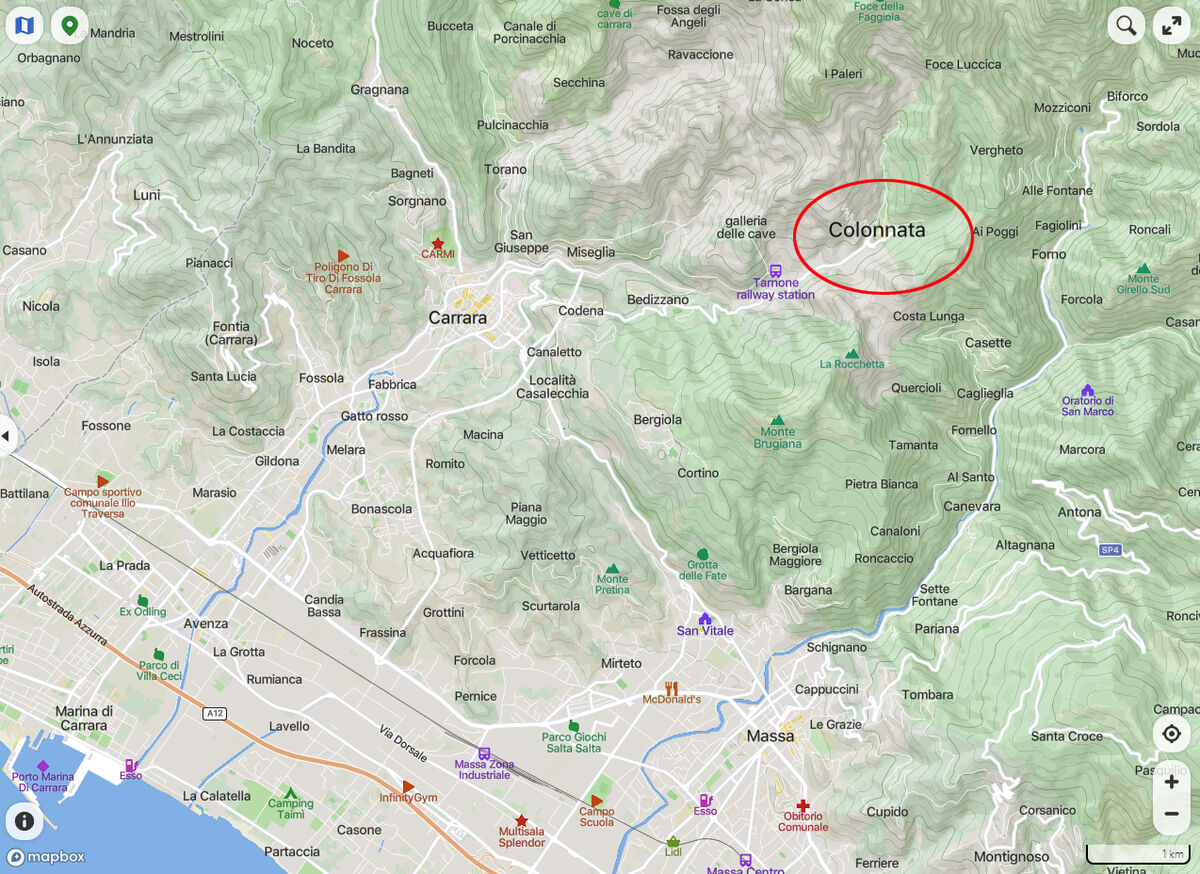Check out Drone Video and Photography Forum section of our forum.
Italy: Tuscany - Colonnata
Oct 9, 2023 15:42:34 #
We arrived in the small mountain town of Colonnata in the rain and transferred from the 4x4s to our motor coach after spending some time in the gift shop. We had lunch in The Lard Rock Cafe and got a chance to sample the local delicacy - Lardo, which I didn't particularly enjoy and Gail refused to taste. The rain started during lunch and I didn't get a chance to take any pictures at the restaurant but you can see what Lardo looks like by clicking the link below..
Lardo is a type of salumi made by curing strips of fatback with rosemary and other herbs and spices.
The most famous lardo is from the Tuscan hamlet of Colonnata, where lardo has been made since Roman times. Colonnata is a frazione of the larger city of Carrara, which is famous for its marble; Colonnata is itself a site where Carrara marble is quarried and, traditionally, lardo is cured for months in basins made of this marble. Lardo di Colonnata is now included in the Ark of Taste catalog of heritage foods as well as enjoying IGP (Protected Geographical Indication) status since 2004. It is composed of over 90% lipids.
Another prized form of lardo is the Valle d'Aosta Lard d'Arnad, a PDO product from the area of Arnad in Aosta Valley of northwest Italy. Both superior types of lardo may be served very thinly sliced as an antipasto.
https://en.wikipedia.org/wiki/Lardo
Colonnata is an Italian ancient village and a hamlet (frazione) of the comune of Carrara, (Massa-Carrara, Tuscany). It is situated in the Apuan Alps, and is known worldwide for the pork fat delicacy Lardo di Colonnata, and for its marble quarries.
History
Colonnata's history dates back to its settlement, around 40 BC. It was built for the housing of slaves used in quarrying marble after Rome decided to replace expensive imported Greek marble with local (Luni) marble.
The name of the settlement is believed derived from the Latin word columna, indicating the place where columns of marble were extracted to be sent to Rome, but the origin of the name could also be the Latin collis ("hill") or columen ( "top").
The quarries may also have been used by the Ligurian Apuani tribe, who were perhaps also used later as quarrying experts. Evidence of mining activity dating back to the 6th century BC has been found at "Fossa Carbonera", Fantiscritti.
Based on a stone found in 1810 bearing the names of the consuls of the years 16 - 22 AD, it appears that the settlement was run by settlers and a magistrate, all of servile origin, who oversaw the work.
Additional records date back only to the 13th century, while the church of the village is believed to date back to the 12th century. It's possible, however, that in the Middle Ages Colonnata was used as a defensive stronghold for those who controlled these areas after the Roman Empire (the Byzantines, the Goths and Lombards).
The village is still mainly supported by mining. The breeding of pigs, promoted by the abundance of chestnut trees, was introduced to Colonnata, perhaps by the Lombard. Over time, this industry evolved, in particular processing freshly slaughtered meat, which was used as bread spread by the quarrymen, thus starting the traditional production of the famous pork fat delicacy, Lardo di Colonnata.
Geography
Location and quarrying
Colonnata is located in the Apuan Alps (mounts Maggiore, Spallone and Sagro), and is accessible by the road that passes through the villages of Vezzala and Bedizzano.
The village is surrounded by quarries in an area known as "Gioia Calagio", which includes the Gioia Pit, which produces the arabescato and bardiglio varieties of veined marble. The quarry was also used in ancient times, as evidenced by the finds of coins, inscriptions engraved directly on the rock, and a relief of the Roman tutelary deity Silvanus.
The largest Roman quarrying site yet discovered was one kilometre south at Fossacava.
Places of interest
The village has maintained some of its historic features, such as the use of marble in murals, doorways, doorjambs, windows and other architectural features. Also to be seen are the north gate into the town, which belonged to the medieval city walls now gone; a yard paved in marble located at the far south end of town; the Piazza Palestro, which leads to a modern sculpture dedicated to Cristo dei Cavatori ("Christ of the Quarrymen"); and the stone bell tower with a view and a clock.
The sixteenth-century San Bartolomeo parish church has a marble interior, including a main altar in white marble, side altars in multi-coloured marble, a marble relief depicting the Assumption of Mary into heaven among the saints, preserved fragments of an ancon from the altar of Saints Andrew, Bartholomew and Peter, and a 17th-century marble crucifix attributed to a pupil of Michelangelo.
https://en.wikipedia.org/wiki/Colonnata
For more images of the Tuscan countryside between Florence and Carrara as well as Carrara Town, the road up the mountain, and the quarry tour, please see my previous posts:
https://www.uglyhedgehog.com/t-787003-1.html#14175832
https://www.uglyhedgehog.com/t-787105-1.html
https://www.uglyhedgehog.com/t-787428-1.html
https://www.uglyhedgehog.com/t-787548-1.html#14186607
https://www.uglyhedgehog.com/t-787640-1.html
https://www.uglyhedgehog.com/t-787821-1.html
https://www.uglyhedgehog.com/t-787902-1.html#14194111
https://www.uglyhedgehog.com/t-788002-1.html#14195991
https://www.uglyhedgehog.com/t-788081-1.html
https://www.uglyhedgehog.com/t-788166-1.html
https://www.uglyhedgehog.com/t-788334-1.html
I hope you enjoy these!
Mark
Lardo is a type of salumi made by curing strips of fatback with rosemary and other herbs and spices.
The most famous lardo is from the Tuscan hamlet of Colonnata, where lardo has been made since Roman times. Colonnata is a frazione of the larger city of Carrara, which is famous for its marble; Colonnata is itself a site where Carrara marble is quarried and, traditionally, lardo is cured for months in basins made of this marble. Lardo di Colonnata is now included in the Ark of Taste catalog of heritage foods as well as enjoying IGP (Protected Geographical Indication) status since 2004. It is composed of over 90% lipids.
Another prized form of lardo is the Valle d'Aosta Lard d'Arnad, a PDO product from the area of Arnad in Aosta Valley of northwest Italy. Both superior types of lardo may be served very thinly sliced as an antipasto.
https://en.wikipedia.org/wiki/Lardo
Colonnata is an Italian ancient village and a hamlet (frazione) of the comune of Carrara, (Massa-Carrara, Tuscany). It is situated in the Apuan Alps, and is known worldwide for the pork fat delicacy Lardo di Colonnata, and for its marble quarries.
History
Colonnata's history dates back to its settlement, around 40 BC. It was built for the housing of slaves used in quarrying marble after Rome decided to replace expensive imported Greek marble with local (Luni) marble.
The name of the settlement is believed derived from the Latin word columna, indicating the place where columns of marble were extracted to be sent to Rome, but the origin of the name could also be the Latin collis ("hill") or columen ( "top").
The quarries may also have been used by the Ligurian Apuani tribe, who were perhaps also used later as quarrying experts. Evidence of mining activity dating back to the 6th century BC has been found at "Fossa Carbonera", Fantiscritti.
Based on a stone found in 1810 bearing the names of the consuls of the years 16 - 22 AD, it appears that the settlement was run by settlers and a magistrate, all of servile origin, who oversaw the work.
Additional records date back only to the 13th century, while the church of the village is believed to date back to the 12th century. It's possible, however, that in the Middle Ages Colonnata was used as a defensive stronghold for those who controlled these areas after the Roman Empire (the Byzantines, the Goths and Lombards).
The village is still mainly supported by mining. The breeding of pigs, promoted by the abundance of chestnut trees, was introduced to Colonnata, perhaps by the Lombard. Over time, this industry evolved, in particular processing freshly slaughtered meat, which was used as bread spread by the quarrymen, thus starting the traditional production of the famous pork fat delicacy, Lardo di Colonnata.
Geography
Location and quarrying
Colonnata is located in the Apuan Alps (mounts Maggiore, Spallone and Sagro), and is accessible by the road that passes through the villages of Vezzala and Bedizzano.
The village is surrounded by quarries in an area known as "Gioia Calagio", which includes the Gioia Pit, which produces the arabescato and bardiglio varieties of veined marble. The quarry was also used in ancient times, as evidenced by the finds of coins, inscriptions engraved directly on the rock, and a relief of the Roman tutelary deity Silvanus.
The largest Roman quarrying site yet discovered was one kilometre south at Fossacava.
Places of interest
The village has maintained some of its historic features, such as the use of marble in murals, doorways, doorjambs, windows and other architectural features. Also to be seen are the north gate into the town, which belonged to the medieval city walls now gone; a yard paved in marble located at the far south end of town; the Piazza Palestro, which leads to a modern sculpture dedicated to Cristo dei Cavatori ("Christ of the Quarrymen"); and the stone bell tower with a view and a clock.
The sixteenth-century San Bartolomeo parish church has a marble interior, including a main altar in white marble, side altars in multi-coloured marble, a marble relief depicting the Assumption of Mary into heaven among the saints, preserved fragments of an ancon from the altar of Saints Andrew, Bartholomew and Peter, and a 17th-century marble crucifix attributed to a pupil of Michelangelo.
https://en.wikipedia.org/wiki/Colonnata
For more images of the Tuscan countryside between Florence and Carrara as well as Carrara Town, the road up the mountain, and the quarry tour, please see my previous posts:
https://www.uglyhedgehog.com/t-787003-1.html#14175832
https://www.uglyhedgehog.com/t-787105-1.html
https://www.uglyhedgehog.com/t-787428-1.html
https://www.uglyhedgehog.com/t-787548-1.html#14186607
https://www.uglyhedgehog.com/t-787640-1.html
https://www.uglyhedgehog.com/t-787821-1.html
https://www.uglyhedgehog.com/t-787902-1.html#14194111
https://www.uglyhedgehog.com/t-788002-1.html#14195991
https://www.uglyhedgehog.com/t-788081-1.html
https://www.uglyhedgehog.com/t-788166-1.html
https://www.uglyhedgehog.com/t-788334-1.html
I hope you enjoy these!
Mark

(Download)

(Download)

(Download)
They were sued by the Hard Rock Cafe but allowed to use the name under license

(Download)

(Download)

(Download)

(Download)

(Download)

(Download)

(Download)
Oct 9, 2023 15:43:18 #
Oct 9, 2023 16:16:55 #
Check out Film Photography section of our forum.
Oct 9, 2023 19:11:03 #
Oct 9, 2023 22:16:33 #
srfmhg wrote:
We arrived in the small mountain town of Colonnata... (show quote)
Another good set Mark. Even out of the way "ordinary" Italian cities are charming and worth visiting.
Oct 9, 2023 22:31:45 #
DJphoto wrote:
Another good set Mark. Even out of the way "ordinary" Italian cities are charming and worth visiting.
They certainly are Dennis. Thanks so much.
Oct 10, 2023 07:19:38 #
Oct 10, 2023 07:24:02 #
Beautifully done, Mark. Loved seeing scenes from the small town. I’ve seen Lardo in Italian delis but it never appealed to me either.
Oct 10, 2023 08:06:37 #
Oct 10, 2023 12:05:58 #
Oct 10, 2023 14:47:51 #
Check out Travel Photography - Tips and More section of our forum.
Oct 10, 2023 14:50:47 #
joehel2 wrote:
Beautifully done, Mark. Loved seeing scenes from the small town. I’ve seen Lardo in Italian delis but it never appealed to me either.
Thanks very much Joe. I guess it’s high energy food which allows them to work long hours in the quarries.
Oct 10, 2023 14:53:21 #
micyclebicycle wrote:
That’s Tuscany?
It certainly is micycle. Colonnata is located in the province of Tuscany which was where we toured.
Oct 10, 2023 14:54:33 #
UTMike wrote:
More of this good tour, Mark!
Thanks very much Mike. The rain cramped my style somewhat but it was brief.
Oct 10, 2023 17:17:33 #
If you want to reply, then register here. Registration is free and your account is created instantly, so you can post right away.
Check out True Macro-Photography Forum section of our forum.








